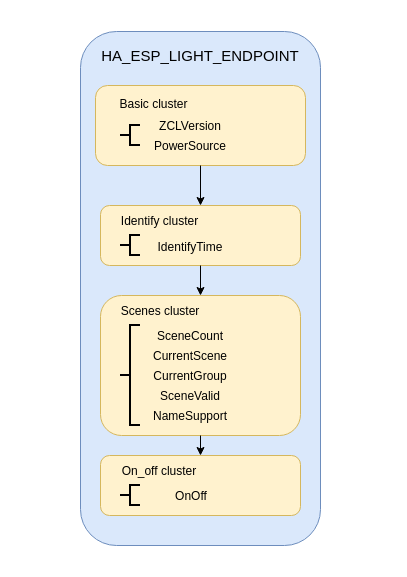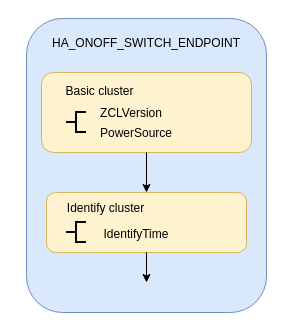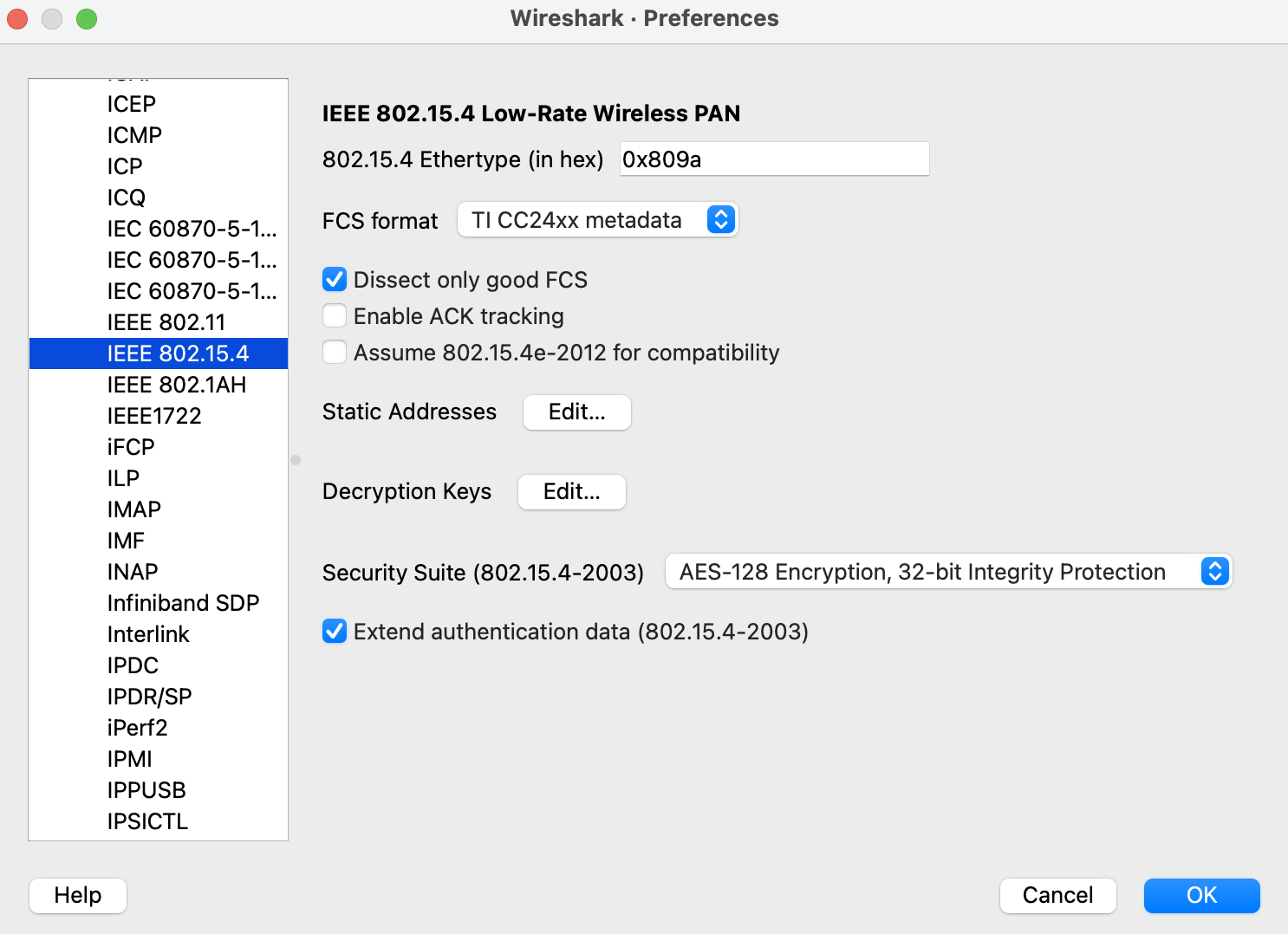2. Developing with ESP Zigbee SDK
Please refer the Release Notes to know more about ESP Zigbee SDK releases. Check README to know more details.
2.1 Development Setup
This section talks about setting up your development environment, fetching the Git repositories, and instructions to build and flash.
2.1.1 Setting up the Repositories
Follow the ESP-IDF getting started guide to set up the IDF development environment. For beginners, please check Installation Step by Step for esp-idf.
Cloning esp-idf:
git clone --recursive https://github.com/espressif/esp-idf.git
cd esp-idf
git checkout v5.3.2
git submodule update --init --recursive
./install.sh
source ./export.sh
cd ..
Cloning esp-zigbee-sdk:
git clone https://github.com/espressif/esp-zigbee-sdk.git
2.1.2 Build and Flash the Applications
Various Zigbee examples are provided with the SDK:
Under an example folder, choose IDF SoC target.
idf.py set-target esp32
If IDF target has not been set explicitly, then
esp32is considered as default.
Build and flash the example.
idf.py -p PORT erase_flash flash monitor
2.2 Running example
See the examples readme for more details: README
2.3 Developing your Product
2.3.1 Data Model
Understanding the structure before actually modifying and customizing the device is helpful.

Node
A node is a single ESP32-H2 based product. It represents a network node in the Zigbee network. A single node can expose multiple endpoints.
Endpoints
Within each node are endpoints. Endpoints, identified by a number between 1 and 240, define each application running in a ZigBee node (yes, a single ZigBee node can run multiple applications). Endpoints serve three purposes in ZigBee:
Endpoints allow for different application profiles to exist within each node.
Endpoints allow for separate control points to exist within each node.
Endpoints allow for separate devices to exist within each node.
Clusters
Clusters, defined by a 16-bit identifier, are application objects. Whereas the NwkAddr and endpoint are addressing concepts, the cluster defines application meaning.
An endpoint can have multiple clusters.
Clusters, in addition to the identifier, have direction. In the SimpleDescriptor which describes an endpoint, a cluster is listed as either input or output.
Clusters contain both code (commands) and data (attributes). Commands cause action. Attributes keep track of the current state of that cluster.
Attributes
Attributes are identified by a 16-bit number, store the current “state” of a given cluster. A data entity which represents a physical quantity or state.
A cluster can have multiple attributes.
There are generic ZCL commands to read and write attributes on any given cluster.
Attributes can even be set up to report automatically at regular intervals, if they change, or both.
2.3.2 A HA_on_off_light example
This section demonstrates how a Home Automation (HA) on_off_light example creates as reference.
See example: HA_on_off_light
2.3.2.1 Data Model
In the standard HA_on_off_light example, we use esp_zb_on_off_light_ep_create() to create a HA on off single endpoint.
Data model looks like:

Above is the endpoint list we created, then we use esp_zb_device_register() to register a Zigbee device.
2.3.2.2 Attribute Callback
An attribute change callback is registered in esp_zb_device_add_set_attr_value_cb() to allow user get notification that certain attributes has changed.
It depends on user how to process those attribute changes based on different circumstances, see the example to handle on_off LED light.
void attr_cb(uint8_t status, uint8_t endpoint, uint16_t cluster_id, uint16_t attr_id, void *new_value)
{
if (cluster_id == ESP_ZB_ZCL_CLUSTER_ID_ON_OFF) {
uint8_t value = *(uint8_t*)new_value;
if (attr_id == ESP_ZB_ZCL_ATTR_ON_OFF_ON_OFF_ID) {
/* implemented light on/off control */
ESP_LOGI(TAG, "on/off light set to %hd", value);
light_driver_set_power((bool)value);
}
} else {
/* Implement some actions if needed when other cluster changed */
ESP_LOGI(TAG, "cluster:0x%x, attribute:0x%x changed ", cluster_id, attr_id);
}
}
2.3.2.3 Zigbee stack Configuring and starting
In this example, a Zigbee end-device is configured to HA_on_off_light. ESP_ZB_ZED_CONFIG() , see esp_zb_cfg_t definition in the API reference chapter below.
Initialize Zigbee stack by using esp_zb_init(), start Zigbee stack by using esp_zb_start() and main loop of the Zigbee stack by using esp_zb_main_loop_iteration().
After Zigbee stack is running, by checking different signals that stack provided, user could start BDB commissioning by using esp_zb_bdb_start_top_level_commissioning().
2.3.3 A HA_on_off_switch example
This section demonstrates how a Home Automation (HA) on_off_switch example creates as reference.
See example: HA_on_off_switch
2.3.2.1 Data Model
In the standard HA_on_off_light example, we use esp_zb_on_off_switch_ep_create() to create a HA on off single endpoint.
Data model looks like:

Above is the endpoint list we created, then we use esp_zb_device_register() to register a Zigbee device.
2.3.2.2 ZCL commands
Varieties of ZCL commands is provided in the esp_zigbee_zcl_command .
In this example we demonstrate a ZCL on_off_toggle command.
After button on the board is pressed, the esp_zb_buttons_handler() creates a on_off toggle command esp_zb_zcl_on_off_cmd_req(). The user has to provide a remote node endpoint, local node endpoint, destination short address, and command type to pack the command request. See esp_zb_zcl_on_off_cmd_t.
static void esp_zb_buttons_handler(switch_func_pair_t *button_func_pair)
{
if (button_func_pair->func == SWITCH_ONOFF_TOGGLE_CONTROL) {
/* implemented light switch toggle functionality */
esp_zb_zcl_on_off_cmd_t cmd_req;
cmd_req.zcl_basic_cmd.dst_addr_u.addr_short = on_off_light.short_addr;
cmd_req.zcl_basic_cmd.dst_endpoint = on_off_light.endpoint;
cmd_req.zcl_basic_cmd.src_endpoint = HA_ONOFF_SWITCH_ENDPOINT;
cmd_req.address_mode = ESP_ZB_APS_ADDR_MODE_16_ENDP_PRESENT;
cmd_req.on_off_cmd_id = ESP_ZB_ZCL_CMD_ON_OFF_TOGGLE_ID;
ESP_EARLY_LOGI(TAG, "send 'on_off toggle' command");
esp_zb_zcl_on_off_cmd_req(&cmd_req);
}
}
2.3.2.3 Zigbee stack Configuring and starting
In this example, a Zigbee coordinator is configured to HA_on_off_switch. ESP_ZB_ZC_CONFIG(), see esp_zb_cfg_t definition in the API reference chapter below.
Initialize Zigbee stack by using esp_zb_init(), start Zigbee stack by using esp_zb_start() and main loop of the Zigbee stack by using esp_zb_main_loop_iteration().
After Zigbee stack is running, by checking different signals that stack provided, user could start BDB commissioning by using esp_zb_bdb_start_top_level_commissioning().
2.4 Debugging
If you encounter any functionality issues with the Zigbee SDK, the following debugging tips may be helpful.
2.4.1 Zigbee API Lock
The Zigbee SDK APIs are not thread-safe, so it’s mandatory to acquire the lock before calling any Zigbee APIs, except for the following cases:
The call site is in Zigbee callbacks which are from Zigbee task.
Calling the schedule alarm APIs, which include esp_zb_scheduler_alarm() and esp_zb_scheduler_alarm_cancel().
An example code block:
#include "esp_zigbee_core.h"
void application_task(void *pvParameters)
{
......
esp_zb_lock_acquire(portMAX_DELAY);
esp_zb_zcl_on_off_cmd_req(cmd_req);
esp_zb_lock_release();
......
}
The same lock is acquired in esp_zb_main_loop_iteration() when the Zigbee task is not idle.
2.4.2 Stack Size
Insufficient stack size often leads to unexpected runtime issues, you may use uxTaskGetStackHighWaterMark() FreeRTOS API to monitor the stack usage of tasks.
2.4.3 Sniffer and Wireshark
Analyzing the packet flow captured by a sniffer is an effective method for understanding Zigbee protocol and troubleshooting issues.
To setup a sniffer for 802.15.4, you’ll require the following:
A 802.15.4 enabled devkit (ESP32-H2, ESP32-C6, etc) running ot_rcp
Follow the steps in Packet Sniffing with Pyspinel to set up the sniffer.
Please note that the Wireshark configuration provided in the link above is intended for the Thread protocol. For Zigbee, you’ll need to make the following configuration:
Go to the Wireshark Preferences > Protocols > IEEE 802.15.4, configure the 802.15.4 as bellow:

Go to the Wireshark Preferences > Protocols > ZigBee:

Add the Pre-configured keys for packet decryption, the default key in the examples is 5A:69:67:42:65:65:41:6C:6C:69:61:6E:63:65:30:39 (“ZigbeeAlliance09”)

Now you can check the Zigbee packet flow in Wireshark.
2.4.4 Enable Debug Mode and Trace Logging
By default, the release version libraries are used for building. Enable ZB_DEBUG_MODE option to use debug version libraries instead, which will output more logs for debugging.
The stack trace logging feature outputs additional logs, here take the HA_on_off_light as an example. To enable trace logging, follow these steps:
Navigate to the example directory and run the command:
idf.py menuconfig
Go to Component config > Zigbee > Zigbee Enable > Zigbee Debug Mode, enable the
Zigbee Debug Modeoption.Call
esp_zb_set_trace_level_mask()beforeesp_zb_init()to configure the trace level and mask. Please refer to esp_zigbee_trace.h for the masks.
#include "esp_zigbee_trace.h"
static void esp_zb_task(void *pvParameters)
{
#if CONFIG_ESP_ZB_TRACE_ENABLE
esp_zb_set_trace_level_mask(ESP_ZB_TRACE_LEVEL_CRITICAL, ESP_ZB_TRACE_SUBSYSTEM_MAC | ESP_ZB_TRACE_SUBSYSTEM_APP);
#endif
/* initialize Zigbee stack */
esp_zb_cfg_t zb_nwk_cfg = ESP_ZB_ZED_CONFIG();
esp_zb_init(&zb_nwk_cfg);
......
}
Enabling trace logging will increase code size. You may need to increase factory partition size in the
partitions.csvfile:
# Name, Type, SubType, Offset, Size, Flags
nvs, data, nvs, 0x9000, 0x6000,
phy_init, data, phy, 0xf000, 0x1000,
factory, app, factory, , 1200K,
zb_storage, data, fat, , 16K,
zb_fct, data, fat, , 1K,
Excessive logging can lead to watchdog timeout for the idle task. Therefore, temporarily disable the idle task watchdog:
`ESP_TASK_WDT_CHECK_IDLE_TASK_CPU0` and `ESP_TASK_WDT_CHECK_IDLE_TASK_CPU1`.
Finally, build and run the example. You will now see more debugging logs in the output.
2.4.5 Assertion Failures
There are certain assertions in the SDK that prevent the stack from running into specific situations. Typically, logs and backtraces from idf.py monitor help identify the location of the assertion issue, so you may figure out what’s wrong with the implementation.
However, this approach may not be effective when the assertion occurs in the Zigbee library due to incomplete debug information in the library. In such cases, you can assist in debugging by sharing us the logs along with the corresponding ELF file (it’s within the project build folder after compilation, e.g., build/on_off_light_bulb.elf).
Please capture the entire log using a serial tool like screen` or minicom. The output will resemble the following:
^[[0;32mI (579) ESP_ZB_ON_OFF_LIGHT: Start network steering^[[0m
^[[0;32mI (2959) ESP_ZB_ON_OFF_LIGHT: Network steering was not successful (status: ESP_FAIL)^[[0m
assert failed: esp_zb_app_signal_handler esp_zb_light.c:70 (false)
Core 0 register dump:
MEPC : 0x4080063e RA : 0x408074c6 SP : 0x4084f090 GP : 0x4080d5a0
TP : 0x4083e428 T0 : 0x37363534 T1 : 0x7271706f T2 : 0x33323130
S0/FP : 0x00000085 S1 : 0x00000001 A0 : 0x4084f0cc A1 : 0x4080da59
A2 : 0x00000001 A3 : 0x00000029 A4 : 0x00000001 A5 : 0x40817000
A6 : 0x00000004 A7 : 0x76757473 S2 : 0x00000009 S3 : 0x4084f1e2
S4 : 0x4080da58 S5 : 0x00000000 S6 : 0x00000000 S7 : 0x00000000
S8 : 0x00000000 S9 : 0x00000000 S10 : 0x00000000 S11 : 0x00000000
T3 : 0x6e6d6c6b T4 : 0x6a696867 T5 : 0x66656463 T6 : 0x62613938
MSTATUS : 0x00001881 MTVEC : 0x40800001 MCAUSE : 0x00000007 MTVAL : 0x00000000
MHARTID : 0x00000000
Stack memory:
4084f090: 0x40809aa6 0x40809ad2 0x42073910 0x4080bdea 0x4080dd04 0x42073910 0x4080dce8 0x4207382c
4084f0b0: 0x4080dd14 0x4084f0c4 0x4080dd18 0x4207381c 0x4080da58 0x00003037 0x4084f520 0x65737361
4084f0d0: 0x66207472 0x656c6961 0x65203a64 0x7a5f7073 0x70615f62 0x69735f70 0x6c616e67 0x6e61685f
4084f0f0: 0x72656c64 0x70736520 0x5f627a5f 0x6867696c 0x3a632e74 0x28203037 0x736c6166 0x42002965
4084f110: 0x00000000 0xffffffff 0x4080f198 0x4084f368 0x00000008 0x4084f158 0x00000003 0x42004ce4
4084f130: 0x00000000 0x00000000 0x00000000 0x0000004b 0x4080f759 0x00000000 0x00000339 0x4204ba5e
4084f150: 0x420737d0 0x420734b4 0x00000042 0x4204be28 0x40850000 0x4084f1e8 0x4080f759 0x4201f83a
4084f170: 0x00000019 0x00000000 0x00000042 0x4201ebb6 0x00000000 0x00000000 0x0000004d 0x000000c0
4084f190: 0x00000019 0x00000000 0x00000000 0x42000000 0x4084fd94 0x40850000 0x0000004d 0x000000c0
4084f1b0: 0x00000019 0xffffffff 0x00000b8f 0x4200756e 0x00000000 0x00001800 0x40817944 0x40800a9c
4084f1d0: 0x00000008 0x4084f208 0x00000003 0x000000c0 0x00001800 0x00000008 0x00000019 0x40800b1c
4084f1f0: 0x00000000 0x00000000 0x00000000 0x00000000 0x00000000 0x00000000 0x0000004d 0x000000c0
4084f210: 0x00000019 0xffffffff 0x4084fd94 0x4200cc44 0x00000000 0x00000000 0x000000aa 0x408107d8
4084f230: 0x00000000 0x00000000 0x00000019 0x4203bc0c 0x00000001 0x00000001 0x00000001 0x4201f05a
4084f250: 0x00000000 0x4203bbb2 0x00190000 0x404f4d19 0x00000000 0x00000000 0x00000000 0x00000000
4084f270: 0x00000000 0x00000000 0x00000000 0x4203b852 0x00000000 0x00000000 0x4084fd74 0x4200ca7e
4084f290: 0x00000000 0x00000000 0x00000000 0x42007178 0x00000008 0x00000000 0x00000000 0x00000000
4084f2b0: 0x00000002 0x00000000 0x00000006 0x00000bb8 0x00000000 0x00000000 0x00000000 0x4080995a
4084f2d0: 0x00000000 0x00000000 0x00000000 0x00000000 0x00000000 0x00000000 0x00000000 0x00000000
4084f2f0: 0x00000000 0xa5a5a5a5 0xa5a5a5a5 0xa5a5a5a5 0xa5a5a5a5 0xa5a5a5a5 0x00000154 0x4084f0e0
4084f310: 0x000000f4 0x4080e534 0x4080e534 0x4084f30c 0x4080e52c 0x00000014 0x4084fe34 0x4084fe34
4084f330: 0x4084f30c 0x00000000 0x00000005 0x4084e308 0x6267695a 0x6d5f6565 0x006e6961 0x00000000
4084f350: 0x00000000 0x4084f300 0x00000005 0x00000001 0x00000000 0x00000000 0x00000009 0x40817bf4
4084f370: 0x40817c5c 0x40817cc4 0x00000000 0x00000000 0x00000001 0x00000000 0x00000000 0x00000000
4084f390: 0x4205ef9e 0x00000000 0x00000000 0x00000000 0x00000000 0x00000000 0x00000000 0x00000000
4084f3b0: 0x00000000 0x00000000 0x00000000 0x00000000 0x00000000 0x00000000 0x00000000 0x00000000
4084f3d0: 0x00000000 0x00000000 0x00000000 0x00000000 0x00000000 0x00000000 0x00000000 0x00000000
4084f3f0: 0x00000000 0x00000000 0x00000000 0x00000000 0x00000000 0x00000000 0x00000000 0x00000000
4084f410: 0x00000000 0x00000000 0x00000000 0x00000000 0x00000000 0x00000000 0x00000000 0x00000000
4084f430: 0x00000000 0x00000000 0x00000000 0x00000000 0x00000000 0x00000000 0x00000000 0x00000000
4084f450: 0x00000000 0x00000000 0x00000000 0x40000000 0x00000054 0x00000000 0x4084f464 0x4084f30c
4084f470: 0x00000001 0x00000000 0x4084f47c 0xffffffff 0x4084f47c 0x4084f47c 0x00000000 0x4084f490
Note
If you encounter any difficulties and require assistance, please don’t hesitate to open a Github issue and include the sniffer capture file, logs and the ELF file. Alternatively,please contact us via technical-inquiries.